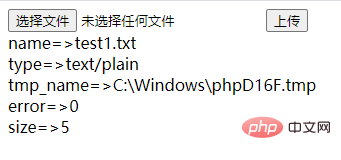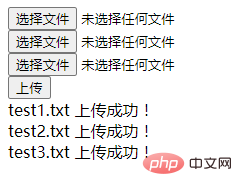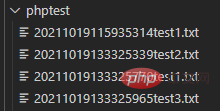 Backend Development
Backend Development
 PHP Problem
PHP Problem
 How to upload files in PHP? You'll understand after reading it!
How to upload files in PHP? You'll understand after reading it!
How to upload files in PHP? You'll understand after reading it!
In the previous article, I brought you "How to obtain and detect file attributes in PHP? (Summary Sharing) ", which gives you a detailed introduction to the knowledge of file attributes in PHP. In this article, let's take a look at how we should upload files in PHP. I hope everyone has to help!

In our daily life, we often encounter the steps of uploading files such as uploading pictures to a circle of friends, sending attached files to emails, etc. In our PHP code , what should I do if I want to upload files? File upload is one of the very important functions in the PHP file system, so let's take a look at how to implement such a function.
Configurationphp.ini
To use the file upload function, first we need to configure php .ini, set the parameters in it appropriately. Let's first take a look at how to find the php.ini file. The example is as follows:
First we input:
1 2 3 |
|
Output result:

From the above results, in You can see the specific path of php.ini in the Loaded Configuration File column. This led to the php.ini file being found.
There are too many files in php.ini. You can use ctrl F to search for related configuration items. Then the parameters we need to configure are as follows:
file_uploads: on means that the server has enabled the file upload function; if it is off, it means that the server has turned off the file upload function. .upload_tmp_dir: Temporary directory for uploading files. Before the file is successfully uploaded, the file will first be stored in the temporary directory on the server side. If it is not set, it will be the system default directory.upload_max_filesize: The maximum size of files allowed to be uploaded by the server, in MB.max_execution_time: The maximum time that a command can be executed in PHP, in seconds.memory_limit: The memory space allocated by a command in PHP, the unit is MB.
What we need to pay attention to is: after the configuration is completed, if you want the configuration to take effect, you need to restart the Apache server for the configured parameters to take effect.
Predefined variable $_FILES
After we configure php.ini, we need to use the predefined variable $_FILES to upload The document makes some restrictions and judgments. The $_FILES variable stores information related to the uploaded file. The information that needs to be saved is as follows:
$_FILES[filename][name]: Save the uploaded file File name$_FILES[filename][size]: Save the size of the uploaded file$ _FILES[filename][tmp_name]: Save the temporary name of the uploaded file##$_FILES[filename][type]
: Save the type of the uploaded file$_FILES[filename][error]
: Save the code name of the uploaded file result, 0 means success
1 2 3 4 5 6 7 8 9 10 11 12 13 14 15 16 17 18 19 20 |
|

Single file upload
Through the above code, we have got the basic information of the file to be uploaded. Next we need to usemove_uploaded_file() Function to implement uploading. Its main function is to move the file just uploaded to a new location. Its syntax format is as follows:
1 |
|
$filenameb represents the file name of the uploaded file. This file name is not the original file name of the uploaded file, but is passed through $_FILES in the previous step. The file name obtained by tmp_name; $destinationb indicates the location to which the uploaded file is to be moved.
1 2 3 4 5 6 7 8 9 10 11 12 13 14 15 16 17 18 19 20 21 22 23 24 25 26 |
|

如此则表示我想要上传的test2.txt已经上传到我需要的目录中了:

多文件上传
通过上述示例已经了解了单文件上传的过程,但是在日常使用中经常会用到的是多文件上传,那多文件上传应该怎么操作呢?
示例如下:
还和上面的示例一样,上传多个文件到我在根目录里创建的phptest文件夹里
1 2 3 4 5 6 7 8 9 10 11 12 13 14 15 16 17 18 19 20 21 22 23 24 25 26 27 28 29 30 |
|
输出结果:

如此结果显示,多个文件已经上传到我的文件夹里了:

推荐学习:《PHP视频教程》
The above is the detailed content of How to upload files in PHP? You'll understand after reading it!. For more information, please follow other related articles on the PHP Chinese website!

Hot AI Tools

Undresser.AI Undress
AI-powered app for creating realistic nude photos

AI Clothes Remover
Online AI tool for removing clothes from photos.

Undress AI Tool
Undress images for free

Clothoff.io
AI clothes remover

Video Face Swap
Swap faces in any video effortlessly with our completely free AI face swap tool!

Hot Article

Hot Tools

Notepad++7.3.1
Easy-to-use and free code editor

SublimeText3 Chinese version
Chinese version, very easy to use

Zend Studio 13.0.1
Powerful PHP integrated development environment

Dreamweaver CS6
Visual web development tools

SublimeText3 Mac version
God-level code editing software (SublimeText3)

Hot Topics
 1660
1660
 14
14
 1416
1416
 52
52
 1310
1310
 25
25
 1260
1260
 29
29
 1233
1233
 24
24
 How do you parse and process HTML/XML in PHP?
Feb 07, 2025 am 11:57 AM
How do you parse and process HTML/XML in PHP?
Feb 07, 2025 am 11:57 AM
This tutorial demonstrates how to efficiently process XML documents using PHP. XML (eXtensible Markup Language) is a versatile text-based markup language designed for both human readability and machine parsing. It's commonly used for data storage an
 Explain JSON Web Tokens (JWT) and their use case in PHP APIs.
Apr 05, 2025 am 12:04 AM
Explain JSON Web Tokens (JWT) and their use case in PHP APIs.
Apr 05, 2025 am 12:04 AM
JWT is an open standard based on JSON, used to securely transmit information between parties, mainly for identity authentication and information exchange. 1. JWT consists of three parts: Header, Payload and Signature. 2. The working principle of JWT includes three steps: generating JWT, verifying JWT and parsing Payload. 3. When using JWT for authentication in PHP, JWT can be generated and verified, and user role and permission information can be included in advanced usage. 4. Common errors include signature verification failure, token expiration, and payload oversized. Debugging skills include using debugging tools and logging. 5. Performance optimization and best practices include using appropriate signature algorithms, setting validity periods reasonably,
 Explain late static binding in PHP (static::).
Apr 03, 2025 am 12:04 AM
Explain late static binding in PHP (static::).
Apr 03, 2025 am 12:04 AM
Static binding (static::) implements late static binding (LSB) in PHP, allowing calling classes to be referenced in static contexts rather than defining classes. 1) The parsing process is performed at runtime, 2) Look up the call class in the inheritance relationship, 3) It may bring performance overhead.
 PHP Program to Count Vowels in a String
Feb 07, 2025 pm 12:12 PM
PHP Program to Count Vowels in a String
Feb 07, 2025 pm 12:12 PM
A string is a sequence of characters, including letters, numbers, and symbols. This tutorial will learn how to calculate the number of vowels in a given string in PHP using different methods. The vowels in English are a, e, i, o, u, and they can be uppercase or lowercase. What is a vowel? Vowels are alphabetic characters that represent a specific pronunciation. There are five vowels in English, including uppercase and lowercase: a, e, i, o, u Example 1 Input: String = "Tutorialspoint" Output: 6 explain The vowels in the string "Tutorialspoint" are u, o, i, a, o, i. There are 6 yuan in total
 What are PHP magic methods (__construct, __destruct, __call, __get, __set, etc.) and provide use cases?
Apr 03, 2025 am 12:03 AM
What are PHP magic methods (__construct, __destruct, __call, __get, __set, etc.) and provide use cases?
Apr 03, 2025 am 12:03 AM
What are the magic methods of PHP? PHP's magic methods include: 1.\_\_construct, used to initialize objects; 2.\_\_destruct, used to clean up resources; 3.\_\_call, handle non-existent method calls; 4.\_\_get, implement dynamic attribute access; 5.\_\_set, implement dynamic attribute settings. These methods are automatically called in certain situations, improving code flexibility and efficiency.
 PHP and Python: Comparing Two Popular Programming Languages
Apr 14, 2025 am 12:13 AM
PHP and Python: Comparing Two Popular Programming Languages
Apr 14, 2025 am 12:13 AM
PHP and Python each have their own advantages, and choose according to project requirements. 1.PHP is suitable for web development, especially for rapid development and maintenance of websites. 2. Python is suitable for data science, machine learning and artificial intelligence, with concise syntax and suitable for beginners.
 PHP in Action: Real-World Examples and Applications
Apr 14, 2025 am 12:19 AM
PHP in Action: Real-World Examples and Applications
Apr 14, 2025 am 12:19 AM
PHP is widely used in e-commerce, content management systems and API development. 1) E-commerce: used for shopping cart function and payment processing. 2) Content management system: used for dynamic content generation and user management. 3) API development: used for RESTful API development and API security. Through performance optimization and best practices, the efficiency and maintainability of PHP applications are improved.
 PHP: A Key Language for Web Development
Apr 13, 2025 am 12:08 AM
PHP: A Key Language for Web Development
Apr 13, 2025 am 12:08 AM
PHP is a scripting language widely used on the server side, especially suitable for web development. 1.PHP can embed HTML, process HTTP requests and responses, and supports a variety of databases. 2.PHP is used to generate dynamic web content, process form data, access databases, etc., with strong community support and open source resources. 3. PHP is an interpreted language, and the execution process includes lexical analysis, grammatical analysis, compilation and execution. 4.PHP can be combined with MySQL for advanced applications such as user registration systems. 5. When debugging PHP, you can use functions such as error_reporting() and var_dump(). 6. Optimize PHP code to use caching mechanisms, optimize database queries and use built-in functions. 7



